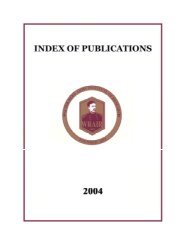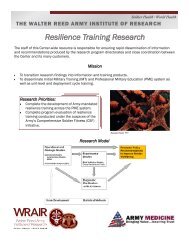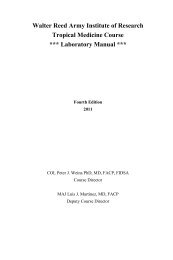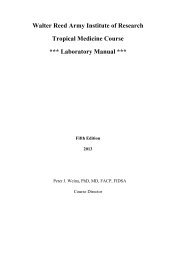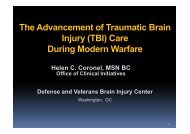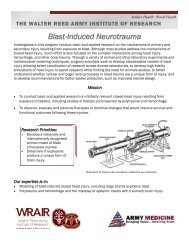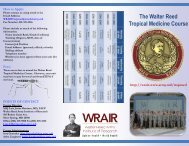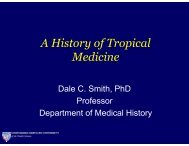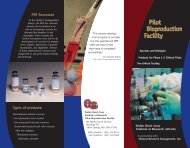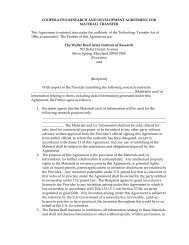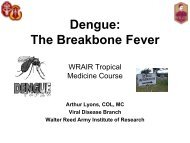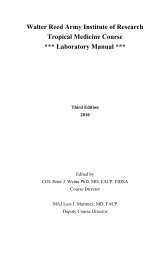LTC Jason Richardson - Walter Reed Army Institute of Research ...
LTC Jason Richardson - Walter Reed Army Institute of Research ...
LTC Jason Richardson - Walter Reed Army Institute of Research ...
Create successful ePaper yourself
Turn your PDF publications into a flip-book with our unique Google optimized e-Paper software.
VECTORS AND DISEASE<br />
Ticks<br />
Sand flies<br />
Mosquitoes<br />
Fleas<br />
Chigger Mites<br />
Lice<br />
Tsetses<br />
<strong>LTC</strong> <strong>Jason</strong> H. <strong>Richardson</strong><br />
<strong>Walter</strong> <strong>Reed</strong> <strong>Army</strong> <strong>Institute</strong> <strong>of</strong> <strong>Research</strong>
OUTLINE<br />
• Threats<br />
• Understanding vectorborne disease epidemiology<br />
• Area specific, risk assessment.<br />
• What are the threats<br />
• Resources<br />
• Where can you find answers<br />
• Prevention<br />
• What can you do to minimize risk
What are the priority threats<br />
It always depends but, in general according<br />
to “the experts”…
PRIORITY THREATS<br />
1. Malaria<br />
2. Dengue<br />
4. Leishmaniasis<br />
13. CCHF<br />
16. Chikungunya<br />
18. Plague<br />
19. Rickettsioses<br />
20. Viral enceph<br />
23. TBE<br />
24. Rift Valley fever<br />
27. Other arboviruses
RISK<br />
What are the threats in my AO<br />
Depends on where you are and when you are<br />
there.
NATURAL NIDALITY OF TRANSMISSIBLE<br />
DISEASES- By E. N. Pavlovsky (1964)<br />
• Pavlovsky introduced the concept <strong>of</strong> natural nidality <strong>of</strong> human<br />
diseases<br />
• Defined by the idea that microscale disease foci are determined by the<br />
entire ecosystem<br />
• Thus the nidus <strong>of</strong> a disease "exists under definite conditions <strong>of</strong> climate,<br />
vegetation, soil, and favorable microclimate.”<br />
• According to Pavlovsky, "nidus" is a translation <strong>of</strong> the root word<br />
"ochag,“ meaning a hearth.<br />
• Thus a nidus <strong>of</strong> disease is its nest, home, or habitat (equivalent to the Latin<br />
"focus").<br />
• The central concept is that a disease has its own natural habitat in<br />
the same way as a species.
Disease Nidality<br />
• E. N. Pavlovsky. 1964. Natural focality <strong>of</strong> transmissive<br />
diseases in connection with landscape epidemiology <strong>of</strong><br />
zooanthroponoses.<br />
• Introduced the Russian word “ochag” meaning hearth or<br />
breeding ground.<br />
• Nidus (Latin) – nest.<br />
• The nidus <strong>of</strong> a disease<br />
"exists under definite conditions<br />
<strong>of</strong> climate, vegetation, soil, and<br />
favorable microclimate.”
Nidality –Landscape Epidemiology<br />
For vector-borne diseases, transmission depends<br />
on the transient interaction <strong>of</strong> a given:<br />
• Vector species<br />
• Pathogen genotype<br />
• Host (human) population<br />
• Ecological setting<br />
Everything depends on space and time
Components <strong>of</strong> transmission<br />
Pathogen<br />
• Imported genotypes, mutations, replication rate<br />
Vector<br />
• Feeding behavior, host preference, habitat, vector<br />
competence, density, life span<br />
Host and reservoir populations<br />
• Immunity, density, living conditions, movement<br />
Landscape<br />
• Climate, rainfall, temp., humidity, habitat<br />
Everything depends on space and time
FACTORS TO HELP ESTIMATE RISK<br />
1. What pathogens and strains/species are present<br />
(P. falciparum is far more serious than P. vivax)<br />
2. Will the mission put personnel into close contact with vectors<br />
• VECTOR BEHAVIOR<br />
• Anopheles mosquitoes are nighttime biters.<br />
• Aedes mosquitoes are daytime biters.<br />
• Sandflies fly close to the ground.<br />
• VECTOR HABITAT…Will personnel operate in areas with vectors<br />
• BILLETING…in buildings with doors and screened windows<br />
3. Will conditions support disease transmission<br />
• SEASONALITY<br />
• RECENT WEATHER (especially rain)<br />
• DENSITY OF VECTOR<br />
• INFECTION RATE<br />
4. What is the Incubation Period
Air Force<br />
Tent City<br />
<strong>Army</strong> Tent City<br />
No AC
Land cover temperature<br />
Extremely variable<br />
(Reisen, 2010)
Epidemiology <strong>of</strong> transmission<br />
Everything depends on space and time<br />
Kyle & Harris, 2008
• Model <strong>of</strong> P. falciparum<br />
• No transmission in areas<br />
surrounded by high<br />
transmission.<br />
• Why...<br />
• No vectors.
HELP IN IDENTIFYING PRIORITY THREATS<br />
Entomological Operational<br />
Risk Assessments<br />
(EORA)<br />
- Provide risk estimates for<br />
vector-borne and zoonotic<br />
diseases in the country <strong>of</strong><br />
concern.<br />
- These estimates, prepared<br />
by USACHPPM.<br />
- EORAs available for >30<br />
countries.<br />
Infectious Disease Risk<br />
Assessment (IDRA)<br />
- AFMIC now NCMI<br />
- Web-based and CD (MEDIC)<br />
- unclassified medical<br />
intelligence
RESOURCES<br />
Where can you find answers<br />
• Public Health Command (PHC), Ento Div<br />
http://chppm-www.apgea.army.mil/ento/default.htm<br />
• AFPMB<br />
http://www.afpmb.org<br />
• NCMI (MEDIC CD)<br />
• <strong>Walter</strong> <strong>Reed</strong> Biosystematics Unit (WRBU)<br />
http://wrbu.si.edu and http://mosquitomap.nhm.ku.edu/vectormap/<br />
• Command PM assets
http://www.<br />
afpmb.org
REGIONAL RISK<br />
DVEPS<br />
- Provide risk estimates for<br />
vector-borne and zoonotic<br />
diseases in the regions <strong>of</strong><br />
concern.<br />
- Prepared by AFPMB.
VECTOR IDENTIFICATION<br />
http://wrbu.si.edu/
‣ Comprised <strong>of</strong> MosquitoMap, SandflyMap and TickMap<br />
‣ Geospatially referenced clearinghouses for arthropod disease<br />
vector species collection records and distribution models.<br />
‣ Users can pan and zoom to anywhere in the world to view the<br />
locations <strong>of</strong>:<br />
‣ past vector collections and<br />
‣ the results <strong>of</strong> modeling that predicts the geographic extent<br />
<strong>of</strong> individual species.<br />
http://mosquitomap.nhm.ku.edu/vectormap/<br />
VectorMap is new and still in the test phase.<br />
Requires you to download Silver Light freeware from Micros<strong>of</strong>t.
Model <strong>of</strong> Plasmodium falciparum in 2005 from the Malaria Atlas Project http://www.map.ox.ac.uk/index.htm.<br />
Hypoendemic, Mesoendemic and Hyper-holoendemic<br />
Several sources <strong>of</strong> information on malaria risk (notably international travel health guidelines on malaria chemoprophylaxis, altitude limits for dominant vectors, climate<br />
limits for malaria transmission and human population density thresholds) have been combined in a GIS to generate this map. See Guerra et al. (2006) Advances in<br />
Parasitology 62: 157 – 179 and Guerra et al. (2006) Trends in Parasitology 22: 353 – 358 for details.<br />
The method for defining the endemic levels within these limits can be found in Snow et al. (2005) Nature 434: 214 – 217.<br />
Anopheles collection records show up as red dots
Tick collection records
Major Vectorborne Disease<br />
Threats<br />
• Malaria<br />
• Dengue<br />
• Leishmaniasis<br />
• Other arboviruses<br />
• (e.g., chikungunya, JEV, WNV)<br />
• Rickettsioses<br />
• (e.g. African tick bite fever, scrub typhus)
Vectorborne Disease Threats<br />
Pages et al., 2010. The past and present<br />
threat <strong>of</strong> vector-borne diseases in deployed
Malaria
s<br />
Malaria
s<br />
Malaria
Malaria<br />
• Risk varies geographically<br />
• Different species <strong>of</strong> Anopheles mosquitoes.<br />
• Entomological inoculation rate (EIR).<br />
• An estimate <strong>of</strong> exposure to infective<br />
mosquitoes,<br />
• EIRs can exceed 1 infective bite per person per<br />
night.
What is a vector<br />
• An arthropod that becomes infected with a<br />
pathogen and is able to transmit it to<br />
another host.<br />
• Although an arthropod is able to maintain a<br />
parasite alive within its body, transmission<br />
depends upon its competence as a vector.
Barriers to Pathogen Transmission<br />
A.N. Clements, Biology <strong>of</strong> Mosquitoes<br />
Posterior<br />
midgut<br />
3<br />
1<br />
2<br />
4<br />
5<br />
1Agent enters midgut in a bloodmea<br />
2 Agent enters epithelial cells and<br />
replicates<br />
3 Agent escapes across basal<br />
lamina and spreads via<br />
4 Agent infects hemolymph salivary glands<br />
5 Agent crosses basal lamina <strong>of</strong><br />
salivary glands and is released<br />
into saliva
Vector potential<br />
• Mosquito species vary in their vector potential<br />
because <strong>of</strong> environmental conditions and factors<br />
affecting their abundance, blood-feeding<br />
behavior, survival, and ability to support<br />
malaria parasite development.<br />
• Sporogony is the complex life cycle <strong>of</strong> the parasite<br />
in female mosquitoes.<br />
• Most individual mosquitoes that ingest<br />
gametocytes do not support development to the<br />
sporozoite stage.
Global distribution (Robinson projection) <strong>of</strong> dominant or potentially important malaria<br />
vectors. From Kiszewksi et al., 2004. American Journal <strong>of</strong> Tropical Medicine and<br />
Hygiene 70(5):486-498.
Biology <strong>of</strong> Anopheles spp.<br />
Eggs<br />
• Eggs are laid individually on the water<br />
surface and are kept afloat by air<br />
chambers (floats).<br />
• Females lay batches <strong>of</strong> 75 to 150 eggs.<br />
• The eggs hatch after two or three days at<br />
temperatures <strong>of</strong> 25-30ºC.<br />
• At lower temperatures, this period can<br />
be longer, and the eggs can resist total or<br />
partial desiccation in moist soil for<br />
many days.
Biology <strong>of</strong> Anopheles spp.<br />
Larvae<br />
• Characteristic resting position,<br />
lying parallel to the water surface.<br />
• Larval development takes around<br />
5 to 7 days.<br />
• Larval habitat varies with species.<br />
Pupae<br />
• Pupae do not eat.<br />
• Metamorphosis <strong>of</strong><br />
the larva into an adult.<br />
• It lasts from two to three days.
Biology <strong>of</strong> Anopheles spp.<br />
Adult:<br />
• Live from 3 to 4 weeks.<br />
• Feeding occurs at night.<br />
• Host preference varies<br />
by species.<br />
• Indoor vs. outdoor<br />
feeding
Biology <strong>of</strong> Anopheles spp.<br />
• Larvae lack a siphon<br />
• Larvae rest parallel to<br />
water surface<br />
• Adults hold body at an<br />
angle <strong>of</strong> 30º degrees or<br />
more with the surface.
Blood required for egg<br />
development
Life cycle <strong>of</strong> Plasmodium<br />
• Mosquito: Sexual<br />
• Man: Asexual
Life cycle <strong>of</strong> Plasmodium<br />
1. Mosquitoes acquire<br />
gametocyte-stage<br />
parasites.<br />
2. The parasites<br />
transform to<br />
ookinetes, then<br />
oocysts, which<br />
produce sporozoites.<br />
Mosquito: Sexual oocyst<br />
Sporozoites released<br />
from ruptured oocyst<br />
Salivary glands<br />
fertilization<br />
exflagellation<br />
3. Sporozoites invade<br />
the salivary glands<br />
and are transmitted<br />
to new host.<br />
gametocytes sporozoites
Life cycle - Sexual stage
Dengue virus vectors
Feeding Habits – Ae. albopictus<br />
• Aedes albopictus prefers to<br />
feed and rest outdoors.<br />
• Feeds during daytime<br />
(diurnal)<br />
• Feeds on any vertebrate<br />
host but prefers humans<br />
Aedes albopictus
Aedes comparison<br />
Ae. aegypti<br />
Ae. albopictus<br />
Environment Urban Sylvatic<br />
Breed/feed Indoors(< 200m) Outdoors<br />
Container type Artificial Natural and artificial<br />
Biting peak Daytime Dusk<br />
Host Human Human/Vertebrates<br />
Flight Range < 200m < 600m
Leishmaniasis
Global distribution <strong>of</strong> the leishmaniases
The Epidemiological Triangle<br />
Enzootic Cycle<br />
Sand fly<br />
Incidental Host<br />
Mammalian<br />
Reservoir<br />
Man and his<br />
Activities
Psammomys obesus<br />
Chenopods<br />
L. major enzootic cycle<br />
7 Oct 2009 Leishmaniasis Slide 48
Characteristics<br />
• Small (2-3 mm)<br />
• Brown (but appear white when illuminated)<br />
• Wings held in erect V-shape<br />
• Nocturnal<br />
• Do not hover<br />
• Silent<br />
• Painful bite
Life cycle and developmental stages<br />
Fourth instar larvae<br />
Adult male<br />
Adult Eggsfemale
Sand flies – vital requirements<br />
• Larvae breed in soil (not aquatic)<br />
• Only females take blood, from a variety <strong>of</strong><br />
vertebrate species<br />
• Rest during the day in dark, humid<br />
microhabitats<br />
• Both sexes require sugar as an energy source
Sand flies resting on wall <strong>of</strong> a chicken house
Rain Forest, desert, mountains, cities
Tick-borne Diseases<br />
African tick-bite fever<br />
(ATBF)<br />
• an emerging infectious<br />
disease endemic in sub-<br />
Saharan Africa<br />
• the most commonly<br />
encountered rickettsiosis<br />
in travel medicine.<br />
• Rickettisia africae<br />
• Amblyomma variegatum<br />
1. Ndip et al., 2011. Risk Factors<br />
for African Tick-Bite Fever in<br />
Rural Central Africa. Am. J.<br />
Trop. Med. Hyg.<br />
2. Raoult et al., 2001. Rickettsia<br />
africae , a tick-borne pathogen<br />
in travelers to sub-Saharan<br />
Africa . N Engl J Med
Prevention
WHAT CAN YOU DO TO MINIMIZE RISK<br />
• Find out what the priority risks are in your area before you<br />
deploy.<br />
• Understand the vectors so you can avoid them.<br />
• Modify behaviors to minimize contact<br />
• Use repellents<br />
• Sleep under insecticide treated netting<br />
• Wear permethrin treated uniforms<br />
• Take malaria chemo (if warranted)<br />
• Call for help:<br />
• AFPMB (CLO) : afpmb-webmaster@osd.mil: subject CLO question<br />
• PHC, Ento Division
Standard Military DEET Skin Repellent<br />
Commercial<br />
Military<br />
33% Controlled-Release DEET Lotion: NSN 6840-01-284-3982<br />
Highest rated skin repellent available (Consumer Reports, May 2003)
CDC recommended repellents<br />
• Of the active ingredients registered with the EPA,<br />
products containing these active ingredients typically<br />
provide longer-lasting protection than others:<br />
DEET, Picaridin, and IR3535<br />
• The three non-DEET compounds work as well as or<br />
nearly as well as DEET when they are used at higher<br />
concentrations (~20%).<br />
http://www.cdc.gov/ncidod/dvbid/westnile/repellentupdates.htm<br />
http://www.epa.gov/pesticides/health/mosquitoes/ai_insectrp.htm<br />
http://www.entomology.wisc.edu/mosquitosite/topicalrepel.html
Picaridin<br />
• Natrapel, 20%, 3.5-oz. Pump Spray<br />
• Cutter Advanced, 7%, 6-oz. Pump<br />
Spray<br />
• Off Skintastic, 5%, 6-oz. Pump<br />
Spray
Picaridin<br />
• Picaridin is a colorless, nearly<br />
odorless liquid active ingredient that<br />
is recommended by the CDC as an<br />
alternative to DEET.<br />
• Lab and field studies <strong>of</strong> products<br />
containing picaridin (10-20%)<br />
indicate good protection.<br />
• 7.5% products are not as effective.
IR3535<br />
• IR3535 is recommended by the CDC<br />
as an alternative to DEET.<br />
• IR3535 is a synthetic insect repellent<br />
structurally similar to a natural amino<br />
acid, beta-alanine and is classified as a<br />
biopesticide by the EPA.<br />
• This compound has been used as a<br />
mosquito repellent in Europe and Asia<br />
for 10-20 years<br />
• Approved by the U.S. EPA in 1999.<br />
• IR3535 is currently available in the<br />
Avon Skin-so-s<strong>of</strong>t Bug Guard 7.5%
Treated Uniforms<br />
• A new training briefing on<br />
permethrin-treated Flame-<br />
Resistant <strong>Army</strong> Combat<br />
Uniforms (FR ACUs) has<br />
been released –CAC<br />
REQUIRED<br />
• https://www.us.army.mil/s<br />
uite/doc/28282876<br />
• https://peosoldier.army.mil<br />
/newpeo/ContactUs/faqs/fr<br />
acu.asp
Bed nets<br />
Enhanced BedNet System 3740-01-546-4354<br />
Improved Bed Net System 3740-01-543-5652<br />
Bed net, Pop-up, self-supporting<br />
Coyote Brown 3740-01-518-7310<br />
OD Green (Camo) 3740-01-516-4415<br />
The pop-up bed net is<br />
factory-treated with<br />
permethrin and has much<br />
finer mesh than the standard<br />
military bed net.
Myth Busters<br />
• No evidence that eating garlic or<br />
taking vitamin B tablets reduces<br />
mosquito bites.<br />
• Dark clothing is usually more<br />
attractive than light colored clothing.<br />
• Drinking alcohol may increase your<br />
attractiveness to mosquitoes.
Myth Busters<br />
• Some mosquito control devices use repellents<br />
to protect a small outdoor area like a patio.<br />
• No products approved by the EPA for indoors.<br />
• Effective devices which use allethrin or other<br />
pyrethroids to repel mosquitoes include:<br />
• Mosquito coils, and<br />
• ThermaCell (TM) Mosquito Repellent System.
Myth Busters
Myth Busters<br />
• Citronella candles are weak.<br />
• Geraniol candles can provide 1 meter <strong>of</strong><br />
protection.
Myth Busters<br />
• Sonic and electronic devices do not work.



